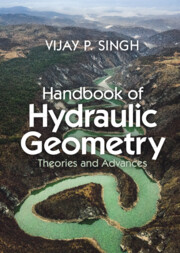Book contents
- Handbook of Hydraulic Geometry
- Handbook of Hydraulic Geometry
- Copyright page
- Dedication
- Contents
- Preface
- Acknowledgments
- 1 Introduction
- 2 Governing Equations
- 3 Regime Theory
- 4 Leopold–Maddock (LM) Theory
- 5 Theory of Minimum Variance
- 6 Dimensional Principles
- 7 Hydrodynamic Theory
- 8 Scaling Theory
- 9 Tractive Force Theory
- 10 Thermodynamic Theory
- 11 Similarity Principle
- 12 Channel Mobility Theory
- 13 Maximum Sediment Discharge and Froude Number Hypothesis
- 14 Principle of Minimum Froude Number
- 15 Hypothesis of Maximum Friction Factor
- 16 Maximum Flow Efficiency Hypothesis
- 17 Principle of Least Action
- 18 Theory of Minimum Energy Dissipation Rate
- 19 Entropy Theory
- 20 Minimum Energy Dissipation and Maximum Entropy Theory
- 21 Theory of Stream Power
- 22 Regional Hydraulic Geometry
- Index
- References
15 - Hypothesis of Maximum Friction Factor
Published online by Cambridge University Press: 24 November 2022
- Handbook of Hydraulic Geometry
- Handbook of Hydraulic Geometry
- Copyright page
- Dedication
- Contents
- Preface
- Acknowledgments
- 1 Introduction
- 2 Governing Equations
- 3 Regime Theory
- 4 Leopold–Maddock (LM) Theory
- 5 Theory of Minimum Variance
- 6 Dimensional Principles
- 7 Hydrodynamic Theory
- 8 Scaling Theory
- 9 Tractive Force Theory
- 10 Thermodynamic Theory
- 11 Similarity Principle
- 12 Channel Mobility Theory
- 13 Maximum Sediment Discharge and Froude Number Hypothesis
- 14 Principle of Minimum Froude Number
- 15 Hypothesis of Maximum Friction Factor
- 16 Maximum Flow Efficiency Hypothesis
- 17 Principle of Least Action
- 18 Theory of Minimum Energy Dissipation Rate
- 19 Entropy Theory
- 20 Minimum Energy Dissipation and Maximum Entropy Theory
- 21 Theory of Stream Power
- 22 Regional Hydraulic Geometry
- Index
- References
Summary
The hypothesis of maximum friction factor states that the channel geometry evolves to a stable nonplanar shape when the friction factor reaches a local maximum. It is supported by published data on bed forms, channels with artificial roughness elements, meandering channels, and bed armoring. This hypothesis can be regarded as an extremal hypothesis. However, this hypothesis may not be invariably true.
- Type
- Chapter
- Information
- Handbook of Hydraulic GeometryTheories and Advances, pp. 407 - 418Publisher: Cambridge University PressPrint publication year: 2022

